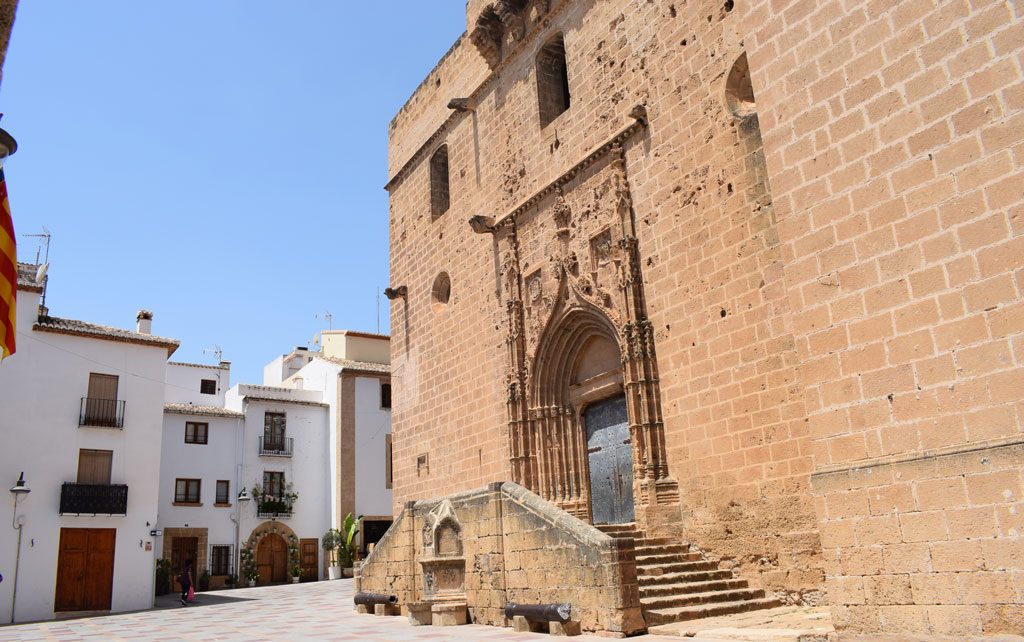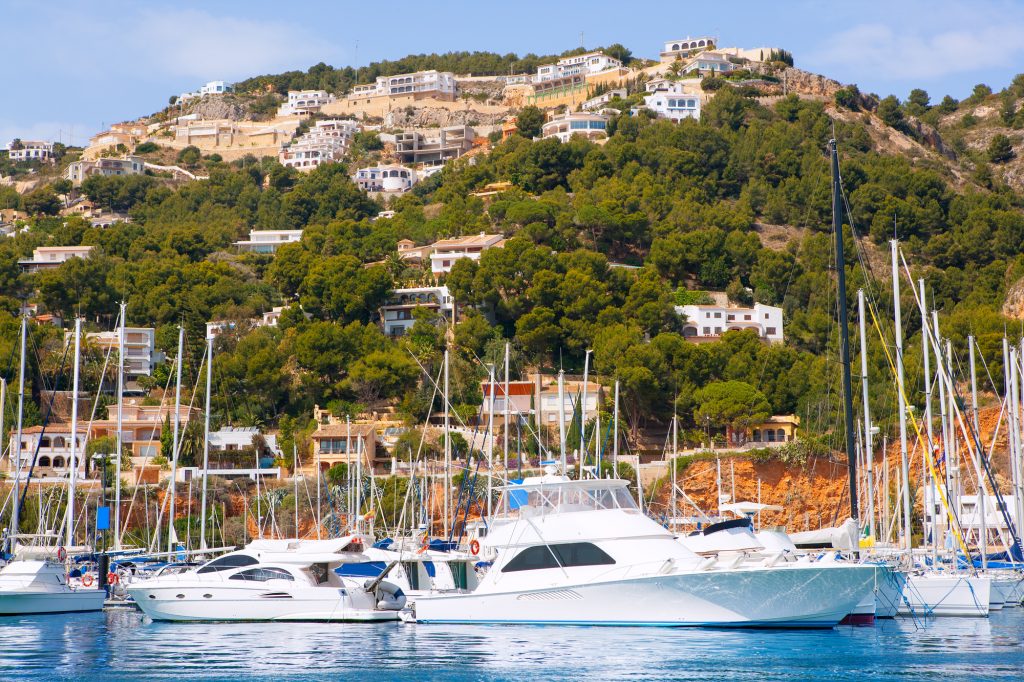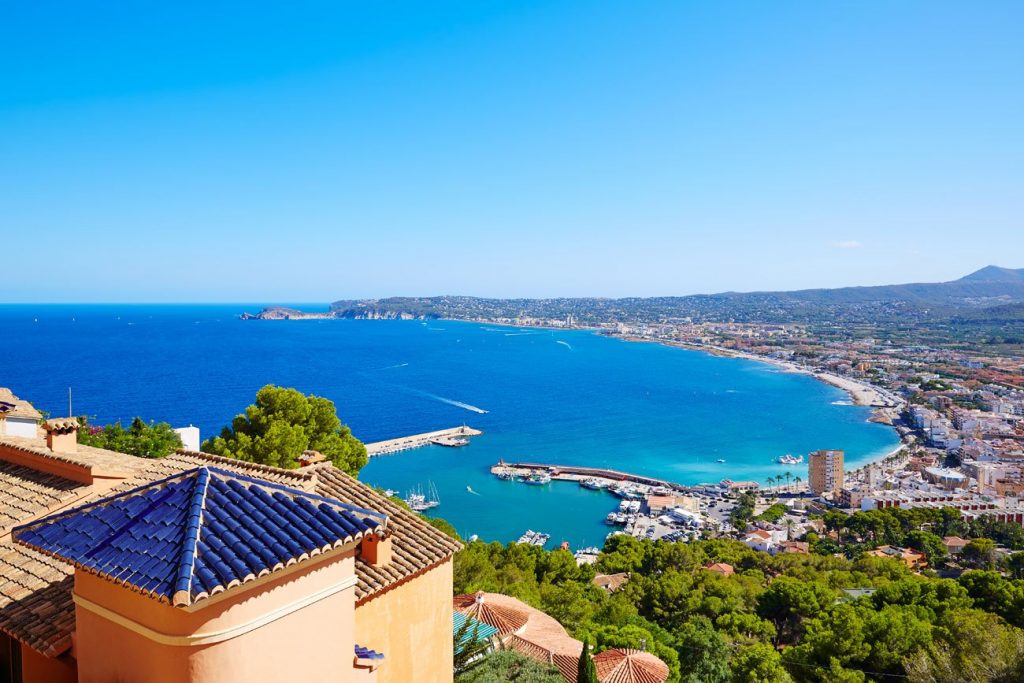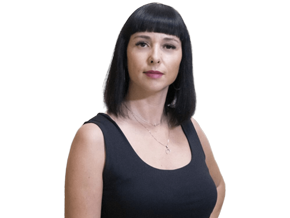Javea is an incredibly beautiful city, located in the north of the Costa Blanca, surrounded by mountains, forests, orange groves and olive groves. In addition, it has a wonderful climate. Javea has been recognized by the UN as one of the best places in the world to live.
The population of Javea, according to 2018 data from the National Statistics Institute (INEC, for its acronym in Spanish), was 27 224 people.
Javea is located in a privileged area between the sea and the mountains. The city is protected from cold winds and rainfall by the capes of San Antonio and Nao, as well as by the mountain range Sierra del Montgó. Thanks to this, the climate in Javea is warm and sunny almost all year round.
Furthermore, Javea has good transport connections with other cities of the Costa Blanca. Javea is 86 km from Alicante (98 km from Alicante Elche airport); 113 km from Valencia; 46 km from Benidorm; 11 km from Denia; 14 km from Moraira; 38 km from Altea; and 155 km from Torrevieja.
The city is divided into three main parts: the old town, the port area and the Arenal beach area.
Javea old town

The historic city centre is located some distance from the sea (about 3 km). The reason why the old town is so far from the sea is that, in ancient times, the city was frequently attacked by pirate raids, forcing its residents to settle far from the coast, surrounded by a protective wall.
The incredible atmosphere that this city once had has been preserved in the old town of Javea: narrow streets; whitewashed facades of traditional houses; bows; gothic windows with wrought iron bars; and rough stone decoration, typical of this area. A walk through the old town is a true journey back through time.
Walking through the old town of Javea, you will see the St. Bartholomew Church-Fortress, from the XIV – XVI centuries, a wonderful example of Gothic architecture. There are nearby the beautiful buildings of great historical value: the Palau dels Sapena (XV century) and the Casa dels Bolufer (XVIII-XIX centuries); as well as the Abastos Municipal Market building (1946) and the Town Hall (18th century, rebuilt in the 20th century).
From here, walking along Calle Primicies, you will find the Soler Blasco Archaeological and Ethnographic Museum, located inside the 17th century palace of Antoni Banyuls. If you continue down Major Street, you will see the Casa de Tena from 1867, where the CA Lambert exhibition hall is currently located. A few meters from here, on the d´Avall street, is the Capella de Santa Anna. Continuing along the Mayor street, you will reach Pl. Del Convent, where the Convento e Iglesia de Agustinas Descalzas.
As you walk up Avenida Príncep d´Asturies, you will come across a reconstructed fragment of an old fortified medieval wall. From here, you can go to Montaner Javea Park, where the Riurau dels Català d´Arnauda historical monument is located, moved here from its original location, and which is evidence of the importance of the raisin trade in this area.
In addition to the historical and architectural monuments, you will find many shops, bars and restaurants in the centre of Javea, many of which have a long history and have been passed down from generation to generation.
At the Abastos Municipal Market, you can buy fresh local products. In addition, once a week (Thursdays, from 8:30 a.m. to 2:00 p.m.), an outlet market is held in the Plaza de la Constitución and the Placeta del Convent.
Javea Port and the Duanes de la Mar neighbourhood

Progressively, the threat of pirate attacks diminished, and in this way the city began to grow, expanding towards the sea.
The port of Javea appeared in the fifteenth century, but until the sixteenth century did not play an important role in the life of the city. From the sixteenth century, the port began to develop rapidly thanks to the raisin trade, which peaked in the nineteenth century. In 1871, the first pier was built. In the late 19th century, the trade in raisins decreased and the port gradually began to become a fishing centre. In addition, a fishermen’s neighbourhood with narrow streets and typical fishermen’s houses grew near the port.
There is a fish market and an auction exchange in the port of Javea, where you can buy fresh seafood and fish.
Not far from the port there is a yacht club that offers various water sports and lots of training.
The area of the port of Javea is the most prestigious and expensive to acquire homes.
The Duanes de la Mar neighbourhood, located next to the port of Javea, is an interesting place to walk with an authentic atmosphere. One of the main attractions of the neighbourhood is the Church of Our Lady of Loreto (Parroquia del Mar), inaugurated in 1967. It is a magnificent example of avant-garde architecture.
Another attraction of Duanes de la Mar is the restored Casa del Cable building from 1860, which today houses the exhibition hall.
Over the years, this neighbourhood has developed without losing its originality and charm. Currently, it is one of the busiest places in the city, where you will find many bars, restaurants and shops.
Also, throughout the year, the Duanes de la Mar neighbourhood becomes the venue for many parties. The most important are the festival of Moors and Christians in July and the festivities in honour of the Virgin of Loreto, the patron saint of the city, in early September.
Arenal beach area in Javea
This is the most popular beach in Javea and the centre of the tourist life of the city. This sandy beach is located in the heart of the bay of Javea, near the port, a short distance from the city centre. This is an ideal place in order to relax with the whole family. It has a well-developed infrastructure, a wide gastronomic offer and plenty of entertainment. Along the beach is the promenade, which is very pleasant for walking. The nightlife is just as lively as the daytime in the summer. British people love the Arenal beach area.
Javea history

Javea is one of the oldest cities on the Costa Blanca, which has preserved vestiges of many cultures and bygone eras. Furthermore, Javea is an important strategic point due to its geographic location.
The oldest findings that testify to the human presence in this area were discovered in the Cova Foradada cave, and date back to the Upper Palaeolithic era (approximately 30 000 years ago). In turn, in the Cova del Montgó cave, ceramic remains, Neolithic burials and the first metal tools from the Bronze Age were found. Likewise, a collective Neolithic burial and religious wall paintings were discovered in the cave Cova del Barranc de Migdía.
Instead, the find called “The Iberian Treasure of Javea”, discovered in 1904, belongs to the era of the Iberians and consists of gold and silver jewellery dating from the IV-II century B.C.
Likewise, the legacy of the Roman Empire is represented by the Necrópolis de Muntagnar and the ruins of a salt trading post.
The era of Muslim rule is represented by many architectural and historical monuments. In addition, the memory of this time has been preserved through many geographical Arabic names of this area.
Also, many architectural monuments have been preserved in Javea since the Middle Ages. Javea has recently experienced a significant increase in the active development of the raisin trade. The city grew significantly, and its infrastructure developed: a port, a theatre and the Bullring were built.
Javea experienced an important demographic growth in the XV century. The city continued to grow while the local bourgeoisie preferred the area around the church of San Bartolomé. You can find Gothic houses from the XV – XVII centuries in the streets of Sor Mª Gallart, Pl. de l’Església, Sta.Marta, Sor Catalina Bas, S. Pere Martir, Metge González, Major, i Estret. A striking example of civil Gothic style is the 15th-century Palau dels Sapena on Plaça de l’Església.
From the end of the 18th century and throughout the 19th century, representatives of the bourgeoisie who were involved in the raisin trade, together with wealthy farmers, built luxury houses in the area of the Church of Our Lady of Loreto, built in 1515 and destroyed in 1870. Here some examples of such houses: Casa dels Bolufer, Casa de les Primícies, Casa Arnauda (or Casa de la Senyoreta Josefina), Casa Abadía, Casa de Montalbán, Casa de Tena (now CA Lambert).
The fortress walls around Jávea were completely demolished due to the expansion of the city, in the period between 1869-1874. This allowed the construction of wide routes for the delivery of goods from the Pl. Del Convento to the port. Currently, these are the avenues Príncep d’Astúries and Av.
D’Alacant. You can see the houses of the merchants who made a fortune through the raisin trade in these avenues. You can also see the building called Riurau de los Català d´Arnauda in the Montaner Park, which was moved here from its original location. This fact shows how important the raisin trade was for Javea. We are talking about one of the special facilities for drying grapes: Riurau.
In addition, the Santa Anna chapel has been preserved since the Middle Ages, and it is located on d’Avall street, It used to belong to the hospital built in 1502, which was not preserved. The chapel is open to visitors from Monday to Friday, from 11:00 a.m. to 1:00 p.m.
Those who are interested in the history of architecture, the Windmills of “La Plana”, from the XIV-XVIII centuries, and the watchtowers Torre Vigía de Ambolo and Torre de Portitxol, from the 16th century, are essential places to visit.
You can get acquainted with the history of Javea, from ancient times to the present day, at the Soler Blasco Archaeological Museum. It is located in the building of the Casa del Palacio Antoni Banyuls (palace-house of Antoni Banyuls).
Javea: places of interest

The best viewpoints of Javea
Lovers of the beautiful views and impressive photos, offered by the viewpoints of Javea, can fully enjoy the beauty of nature in this area. Below, you will find a list of the best viewpoints in Javea:
- Cap de Sant Antoni
- El Molins
- Punta del Castell
- Séquia de la Nòria
- Cala Blanca
- Caletes
- Creu del Portitxol
- L´Illa
- La Falzia
- Cap Negre
- Cap de la Nau
- Granadella
- Les Pesqueres
- Ambolo
- Castell de la Granadella
Montgó Natural Park
The Montgó mountain range, which rises above the plains of Javea, Denia and Ondara, is one of the most picturesque places on the Costa Blanca. It has a unique flora and fauna, as well as an incredible variety of landscapes. The maximum height of the ridge is 753 m above sea level.
The Montgó Massif declared an officially protected nature reserve in 1987. In addition to the mountain range itself, the park includes the San Antonio cape and the Las Planas grassland.
The steep cliffs that break into the sea, the majestic peaks, the deep ravines, the impressive views and a large number of routes of different difficulty make this park a great place for outdoor activities.
Cap de Sant Antoni Marine Reserve
The Cap de Sant Antoni or Cabo de San Antonio is located in the transition zone between the sandy coast of the Gulf of Valencia and the cliffs that rise above the sea, in the northern part of Alicante. This uniqueness gives the coastal landscape of the area an incredible beauty and a picturesque character.
The seabed in the Cabo de San Antonio area, is characterized by having a surprising topographical and biological diversity: many species of plants and animals live in this small area, many of which are protected.
Booklet of the Cap de Sant Antoni Marine Reserve (in Spanish), see here.
Portitxol cove

The Portitxol cove, bounded from the north by the Cap Prim cape, and from the south by the Cap Negre cape, is one of the most beautiful places in Javea. There are two micro reserves. The area is characterized by its biogeographic diversity and it is of great interest among hiking lovers.
La Granadella Forest Park
There is a large green massif on the southern coast of Javea, with an area of about 700 hectares. Shrubs and low meadows mainly predominate here. Also, there are native plants in this area.
Javea beaches and coves
The coast of Javea offers sea lovers many wonderful places to relax. You will find beaches and coves for all tastes here.
El Arenal beach

- Length: 450 m.
- Blue flag
An urban beach located in the centre of the bay of Xabia. It is the only sandy beach in Javea. It is the most popular beach of the area and it is the tourist life core of the city.
El Arenal beach on the map
Blanca cove

- Length: 300 m.
Rocky cove with beautiful views of the Montgó Massif.
Blanca cove on the map
Sardinera cove

- Length: 500 m.
A picturesque and isolated cove. Ideal to relax in the lap of nature.
Sardinera cove on the map
La Grava beach

- Length: 550 m.
- Blue flag
A pebble beach of crystal-clear water, located near the centre of Javea. Great place to relax with the whole family.
La Grava beach on the map
La Granadella cove

- Length: 220 m.
- Blue flag
A picturesque rocky cove. Great place to go diving and snorkelling.
La Granadella cove on the map
Portixol / La Barraca cove

- Length: 600 m.
A beautiful rocky cove of crystal-clear waters. Ideal for snorkelling lovers. There is the Portitxol Island nearby.
Portixol / La Barraca cove on the map
Muntanyar beach

- Muntanyar I Length: 1600 m.
- Muntanyar II Length: 1700 m.
It is a rocky beach with many different types of water leisure activities. It is divided into two parts: Primer Muntanyar / Benissero / Muntanyar I y Segon Muntanyar / Muntanyar II
Muntanyar I on the map
Muntanyar II on the map
Ambolo cove

- Length: 300 m.
A wild nudist beach located south of Cape Nao.
Ambolo cove on the map
Read more about the best beaches of the Costa Blanca, here.
Festivities of Javea

People in Javea, as well as throughout Spain, are very fond of parties and festivals which take place on a large scale and they often take place over several days.
Javea celebrates in winter the Christmas festivities, the festivities in honour of San Antonio (San Antonio Festival) and the festivities in honour of San Sebastián, the patron saint of the city. The traditional Carnival is celebrated in February and March.
Other processions are held in Javea in spring, during Easter, as well as a traditional fair in the historic centre of the city. The festivities in honour of Jesús the Nazarene are held in late April and early May.
The city celebrates the feast of San Juan in June, and in July, a feast in honour of the Virgin of Carmen, the patron saint of sailors and fishermen. Also, in Javea, the “Moors and Christians” festival and the Living Chess festival are held in the Xabia port (last Saturday in July). The latter is recognized as an event of national tourist interest.
The festivities in honour of the Virgin of Loreto are held in Javea at the end of August and beginning of September; and the festivity in honour of Saint Lucia is celebrated in December.
You can see the complete calendar of all the festivities in Jávea in this link, through the official website of Jávea.
Housing in Javea

Javea is one of the most expensive places of the Costa Blanca in order to buy properties, and this is not surprising, as it is a truly ideal place to live.
The average cost, per square meter, of housing in Javea, according to March 2020 data from the Idealista website, is € 2331. The only area of Javea where the average cost of housing does not exceed € 2000, is the old city centre – Centro Ciudad. Housing here is mainly represented by old buildings. Also, this area is far from the sea.
The most expensive areas of Javea are Port (€ 3299) and Montañar-El Arenal (€ 2568). You will find a large supply of new build homes here, mostly modern luxury apartments. In addition, this is a great area in order to purchase seaside homes.
The greatest offer of houses may be found in the areas of Cap Martí – Pinomar, Partida Comunes-Adsubia and Portichol – Balcón al Mar.
Housing in Javea is also an excellent investment option: Javea is a popular tourist destination but there are few hotels here, therefore tourist rentals are in high demand.
Javea or Calpe: where to live?
Those who plan to move permanently to the north of the Costa Blanca, often ask themselves: Javea or Calpe, which one to choose? Which city is better? Unfortunately, there is no a definitive answer to this question, as both cities are wonderful, each in its own way, and at the same time, they have a number of features in common. The cost of housing in Calpe is slightly lower than in Javea, an average of € 2077 per square meter, against € 2331 in Javea.
Regarding the supply of housing, both cities offer options for all tastes and budgets. However, this is the most important factor: It is advisable to choose a good specialist, who will help you find the perfect home that meets all your requirements.
What is advisable? Trust only your intuition. Take all the necessary time in order to choose. Carefully study both cities and, if possible, live at least a few days in both. In this way, you can determine which of the two cities you like best.
Whatever city you choose, you will not be disappointed!
The entire offer of real estate in Javea from the company “Alegría”, can be found here.



